Assessing Changes in Sodium Content of Selected Popular Commercially Processed and Restaurant Foods: Results from the USDA: CDC Sentinel Foods Surveillance Program
Abstract
1. Introduction
2. Methods
2.1. Selection of Sentinel Foods
2.2. Assessment of Baseline Sodium Content
2.3. Tracking Changes in Nutrient Values
2.4. Comparison of Changes in Labels and Laboratory Sodium at Brand Level
2.5. Comparison to FDA’s Draft Voluntary Sodium-Reduction Targets
2.6. Comparison to FDA Sodium Limits for ‘Healthy’ Foods
2.7. Statistical Analysis
3. Results
3.1. Tracking Changes in Label Sodium Values
3.2. Tracking Changes in Laboratory Nutrient Values
4. Discussion
Strengths and Limitations
5. Conclusions
Supplementary Materials
Author Contributions
Funding
Conflicts of Interest
References
- Stallings, V.; Harrison, M.; Oria, M. Dietary Reference Intakes for Sodium and Potassium; The National Academies Press: Washington, DC, USA, 2019; pp. 1–14. [Google Scholar]
- Aburto, N.J.; Ziolkovska, A.; Hooper, L.; Elliott, P.; Cappuccio, F.P.; Meerpohl, J.J. Effect of Lower Sodium Intake on Health: Systematic Review and Meta-Analyses. BMJ 2013, 346, f1326. Available online: https://www.bmj.com/content/346/bmj.f1326 (accessed on 9 May 2019). [CrossRef] [PubMed]
- Strom, B.L.; Yaktine, A.L.; Oria, M. Sodium Intake in Populations: Assessment of Evidence; National Academies Press: Washington, DC, USA, 2013; pp. 1–10. [Google Scholar]
- Carriquiry, A.; Moshfegh, A.J.; Steinfeldt, L.C.; Cogswell, M.E.; Loustalot, F.; Zhang, Z.; Yang, Q.; Tian, N. Trends in the Prevalence of Excess Dietary Sodium Intake—United States, 2003–2010. MMWR. Morb. Mortal. Wkly. Rep. 2013, 62, 1021. Available online: https://www.ncbi.nlm.nih.gov/pmc/articles/PMC4584577/ (accessed on 16 July 2019).
- U.S. Department of Health and Human Services and U.S. Department of Agriculture. 2015–2020 Dietary Guidelines for Americans. Available online: https://health.gov/dietaryguidelines/2015/guidelines/ (accessed on 26 March 2019).
- U.S. Department of Health and Human Services; Office of Disease Prevention and Health Promotion. Food and Nutrient Consumption. NWS-19 Reduce Consumption of Sodium in the Population Aged 2 Years and Older. Available online: https://www.healthypeople.gov/2020/topics-objectives/objective/nws-19 (accessed on 26 March 2019).
- Drewnowski, A.; Rehm, C. Sodium Intakes of US Children and Adults from Foods and Beverages by Location of Origin and by Specific Food Source. Nutrients 2013, 5, 1840–1855. Available online: https://www.mdpi.com/2072-6643/5/6/1840 (accessed on 9 May 2019). [CrossRef] [PubMed]
- Harnack, L.J.; Cogswell, M.E.; Shikany, J.M.; Gardner, C.D.; Gillespie, C.; Loria, C.M.; Zhou, X.; Yuan, K.; Steffen, L.M. Sources of Sodium in US Adults from 3 Geographic Regions. Circulation 2017, 135, 1775–1783. Available online: https://www.ahajournals.org/doi/full/10.1161/CIRCULATIONAHA.116.024446?url_ver = Z39.88-2003&rfr_id = ori:rid:crossref.org&rfr_dat = cr_pub%3dpubmed (accessed on 9 May 2019). [CrossRef] [PubMed]
- World Health Organization. Salt Reduction and Iodine Fortification Strategies in Public Health: Report of a Joint Technical Meeting Convened by the World Health Organization and The George Institute for Global Health in Collaboration with the International Council for the Control of Iodine Deficiency Disorders Global Network; World Health Organization: Sydney, Australia, March 2013. [Google Scholar]
- Smith-Spangler, C.M.; Juusola, J.L.; Enns, E.A.; Owens, D.K.; Garber, A.M. Population Strategies to Decrease Sodium Intake and the Burden of Cardiovascular Disease: A Cost-Effectiveness Analysis. Ann. Intern. Med. 2010, 152, 481–487. Available online: https://www.annals.org/article.aspx?doi = 10.7326/0003-4819-152-8-201004200-00212 (accessed on 9 May 2019). [CrossRef] [PubMed]
- He, F.; Brinsden, H.; MacGregor, G. Salt Reduction in the United Kingdom: A Successful Experiment in Public Health. J. Hum. Hypertens. 2014, 28, 345. Available online: https://www.nature.com/articles/jhh2013105 (accessed on 9 May 2019). [CrossRef] [PubMed]
- Institute of Medicine. Strategies to Reduce Sodium Intake in the United States; National Academies Press: Washington, DC, USA, 2010; 297p. [Google Scholar]
- ConAgra Foods. ConAgra Foods to Reduce Sodium in Products by 20 Percent by 2015. Available online: https://www.conagrabrands.com/news-room/news-conagra-foods-to-reduce-sodium-in-products-by-20-percent-by-2015-1342465 (accessed on 27 March 2019).
- McDonald’s USA. McDonald’s USA: Commitments to Offer Improved Nutrition Choices. Available online: https://news.mcdonalds.com/news-releases/news-release-details/mcdonalds-usa-commitments-offer-improved-nutrition-choices (accessed on 27 March 2019).
- PR Newswire. Kraft Foods on Track to Meet Sodium Reduction Goals Across North American Product Portfolio. Available online: https://www.prnewswire.com/news-releases/kraft-foods-on-track-to-meet-sodium-reduction-goals-across-north-american-product-portfolio-171344191.html (accessed on 27 March 2019).
- General Mills. General Mills Reports Progress on Pledge to Reduce Sodium. Available online: https://www.generalmills.com/en/News/NewsReleases/Library/2015/December/sodium-reduction (accessed on 27 March 2019).
- City of New York. National Salt Reduction Initiative Corporate Commitments. Available online: https://www1.nyc.gov/assets/doh/downloads/pdf/cardio/nsri-corporate-commitments.pdf (accessed on 27 March 2019).
- US Food and Drug Administration. Draft Guidance for Industry: Voluntary Sodium Reduction Goals: Target Mean and Upper Bound Concentrations for Sodium in Commercially Processed, Packaged, and Prepared Foods. Available online: https://www.fda.gov/Food/GuidanceRegulation/GuidanceDocumentsRegulatoryInformation/ucm494732.htm (accessed on 27 March 2019).
- Ahuja, J.K.; Wasswa-Kintu, S.; Haytowitz, D.B.; Daniel, M.; Thomas, R.; Showell, B.; Nickle, M.; Roseland, J.M.; Gunn, J.; Cogswell, M. Sodium Content of Popular Commercially Processed and Restaurant Foods in the United States. Prev. Med. Rep. 2015, 2, 962–967. Available online: https://www.sciencedirect.com/science/article/pii/S2211335515001606 (accessed on 9 May 2019). [CrossRef] [PubMed]
- Ahuja, J.K.; Pehrsson, P.R.; Haytowitz, D.B.; Wasswa-Kintu, S.; Nickle, M.; Showell, B.; Thomas, R.; Roseland, J.; Williams, J.; Khan, M. Sodium Monitoring in Commercially Processed and Restaurant Foods. Am. J. Clin. Nutr. 2015, 101, 622–631. Available online: https://www.ncbi.nlm.nih.gov/pmc/articles/PMC4501259/ (accessed on 9 May 2019). [CrossRef] [PubMed]
- U.S. Department of Agriculture; Agricultural Research Service; Beltsville Human Nutrition Research Center; Group, F.S.R.; U.S. Department of Health and Human Services; Centers for Disease Control and Prevention; National Center for Health Statistics. What We Eat in America, National Health and Nutrition Examination Survey (NHANES) 2015–2016. Available online: https://www.ars.usda.gov/northeast-area/beltsville-md-bhnrc/beltsville-human-nutrition-research-center/food-surveys-research-group/docs/wweia-data-tables/ (accessed on 5 December 2018).
- U.S. Department of Agriculture. What We Eat in America: Food Categories 2011–2012. Available online: https://www.ars.usda.gov/ARSUserFiles/80400530/pdf/1314/food_category_list.pdf (accessed on 27 March 2019).
- Pehrsson, P.; Perry, C.; Daniel, M. ARS, USDA Updates Food Sampling Strategies to Keep Pace with Demographic Shifts. Procedia Food Sci. 2013, 2, 52–59. Available online: https://www.sciencedirect.com/science/article/pii/S2211601X13000102 (accessed on 9 May 2019). [CrossRef]
- Pehrsson, P.; Haytowitz, D.; Holden, J. The USDA’s National Food and Nutrient Analysis Program: Update 2002. J. Food Compos. Anal. 2003, 16, 331–341. Available online: https://www.sciencedirect.com/science/article/pii/S0889157503000498 (accessed on 9 May 2019). [CrossRef]
- The Nielsen Company. Available online: https://www.nielsen.com/us/en.html (accessed on 27 March 2019).
- Phillips, K.M.; Patterson, K.Y.; Rasor, A.S.; Exler, J.; Haytowitz, D.B.; Holden, J.M.; Pehrsson, P.R. Quality-Control Materials in the USDA National Food and Nutrient Analysis Program (NFNAP). Anal. Bioanal. Chem. 2006, 384, 1341–1355. Available online: https://link.springer.com/article/10.1007%2Fs00216-005-0294-0 (accessed on 9 May 2019). [CrossRef] [PubMed]
- US Department of Agriculture; Agricultural Research Service; Nutrient Data Laboratory. USDA National Nutrient Database for Standard Reference, Release 28 (2015). Documentation and User Guide. Available online: https://www.ars.usda.gov/ARSUserFiles/80400525/Data/SR/sr28/sr28_doc.pdf (accessed on 24 July 2019).
- Information Resources Inc. (IRI). FreshLook Report. Dataset; Information Resources Inc.: Chicago, IL, USA, 2016. [Google Scholar]
- Ahuja, J.K.; Li, Y.; Nickle, M.S.; Haytowitz, D.B.; Roseland, J.; Nguyen, Q.; Khan, M.; Wu, X.; Somanchi, M.; Williams, J. Comparison of Label and Laboratory Sodium Values in Popular Sodium-Contributing Foods in the United States. J. Acad. Nutr. Diet. 2019, 119, 293–300. Available online: https://www.sciencedirect.com/science/article/pii/S2212267218318665?via%3Dihub (accessed on 9 May 2019). [CrossRef] [PubMed]
- Centers for Disease Control Prevention. Vital signs: Food categories contributing the most to sodium consumption-United States, 2007–2008. MMWR Morbid. Mortal. Wkly. Rep. 2012, 61, 92. [Google Scholar]
- U.S. Food and Drug Administration. Title 21: Food and Drugs §101.65 Implied Nutrient Content Claims and Related Label Statements. Available online: https://www.ecfr.gov/cgi-bin/text-idx?SID = 498a0eac418638c57d5abf4bdbb3751f&mc = true&node = se21.2.101_165&rgn = div8 (accessed on 28 March 2019).
- R Core Team. R: A Language and Environment for Statistical Computing. Available online: https://www.R-project.org/ (accessed on 28 February 2019).
- Lenth, R. Emmeans: Estimated Marginal Means, aka Least-Squares Means. R Package Version 1.3.2. Available online: https://CRAN.R-project.org/package = emmeans (accessed on 28 March 2019).
- U.S. Food and Drug Administration. Guidance for Industry: A Food Labeling Guide. Available online: http://www.fda.gov/Food/GuidanceRegulation/GuidanceDocumentsRegulatoryInformation/LabelingNutrition/ucm2006828.htm (accessed on 24 July 2019).
- Gillespie, C.; Maalouf, J.; Yuan, K.; Cogswell, M.E.; Gunn, J.P.; Levings, J.; Moshfegh, A.; Ahuja, J.K.; Merritt, R. Sodium Content in Major Brands of US Packaged Foods, 2009. Am. J. Clin. Nutr. 2014, 101, 344–353. Available online: https://academic.oup.com/ajcn/article/101/2/344/4494391 (accessed on 9 May 2019). [CrossRef] [PubMed]
- Clapp, J.E.; Niederman, S.A.; Leonard, E.; Curtis, C.J. Changes in Serving Size, Calories, and Sodium Content in Processed Foods From 2009 to 2015. Prev. Chronic Dis. 2018, 15, E33. Available online: http://europepmc.org/abstract/MED/29543584 (accessed on 9 May 2019). [CrossRef] [PubMed]
- Poti, J.M.; Dunford, E.K.; Popkin, B.M. Sodium Reduction in US Households’ Packaged Food and Beverage Purchases, 2000 to 2014. JAMA Intern. Med. 2017, 177, 986–994. Available online: https://jamanetwork.com/journals/jamainternalmedicine/fullarticle/2629447 (accessed on 9 May 2019). [CrossRef]
- Jacobson, M.F.; Havas, S.; McCarter, R. Changes in sodium levels in processed and restaurant foods, 2005 to 2011. JAMA Intern. Med. 2013, 173, 1285–1291. [Google Scholar] [CrossRef]
- Wolfson, J.A.; Moran, A.J.; Jarlenski, M.P.; Bleich, S.N. Trends in Sodium Content of Menu Items in Large Chain Restaurants in the US. Am. J. Prev. Med. 2018, 54, 28–36. Available online: https://www.sciencedirect.com/science/article/pii/S0749379717304592?via%3Dihub (accessed on 9 May 2019). [CrossRef] [PubMed]
- U.S. Food and Drug Administration. Overview of FDA Labeling Requirements for Restaurants, Similar Retail Food Establishments and Vending Machines. Available online: https://www.fda.gov/Food/GuidanceRegulation/GuidanceDocumentsRegulatoryInformation/LabelingNutrition/ucm248732.htm (accessed on 9 May 2018).
- U.S. Food and Drug Administration. Guidance for Industry: Nutrition Labeling Manual-A Guide for Developing and Using Data Bases. Available online: https://www.fda.gov/Food/GuidanceRegulation/GuidanceDocumentsRegulatoryInformation/LabelingNutrition/ucm063113.htm#how (accessed on 17 February 2017).
- Gelski, J. Shhh! Sodium Reduction in Progress. Food Business News. Available online: http://www.foodbusinessnews.net/articles/news_home/Consumer_Trends/2013/10/Shhh_Sodium_reduction_in_progr.aspx?ID = %7B1D24AAE5-DF99-4070-86A1-C945A9C37E85%7D&cck = 1 (accessed on 9 May 2019).
- Cogswell, M.E.; Patel, S.M.; Yuan, K.; Gillespie, C.; Juan, W.; Curtis, C.J.; Vigneault, M.; Clapp, J.; Roach, P.; Moshfegh, A. Modeled Changes in US Sodium Intake from Reducing Sodium Concentrations of Commercially Processed and Prepared Foods to Meet Voluntary Standards Established in North America: NHANES. Am. J. Clin. Nutr. 2017, 106, 530–540. Available online: https://academic.oup.com/ajcn/article-lookup/doi/10.3945/ajcn.116.145623 (accessed on 9 May 2019). [CrossRef] [PubMed]
- Taylor, C.; Doyle, M.; Webb, D. “The Safety of Sodium Reduction in the Food Supply: A Cross-Discipline Balancing Act”—Workshop Proceedings. Crit. Rev. Food Sci. Nutr. 2018, 58, 1650–1659. Available online: https://www.tandfonline.com/doi/full/10.1080/10408398.2016.1276431 (accessed on 9 May 2019). [CrossRef] [PubMed]
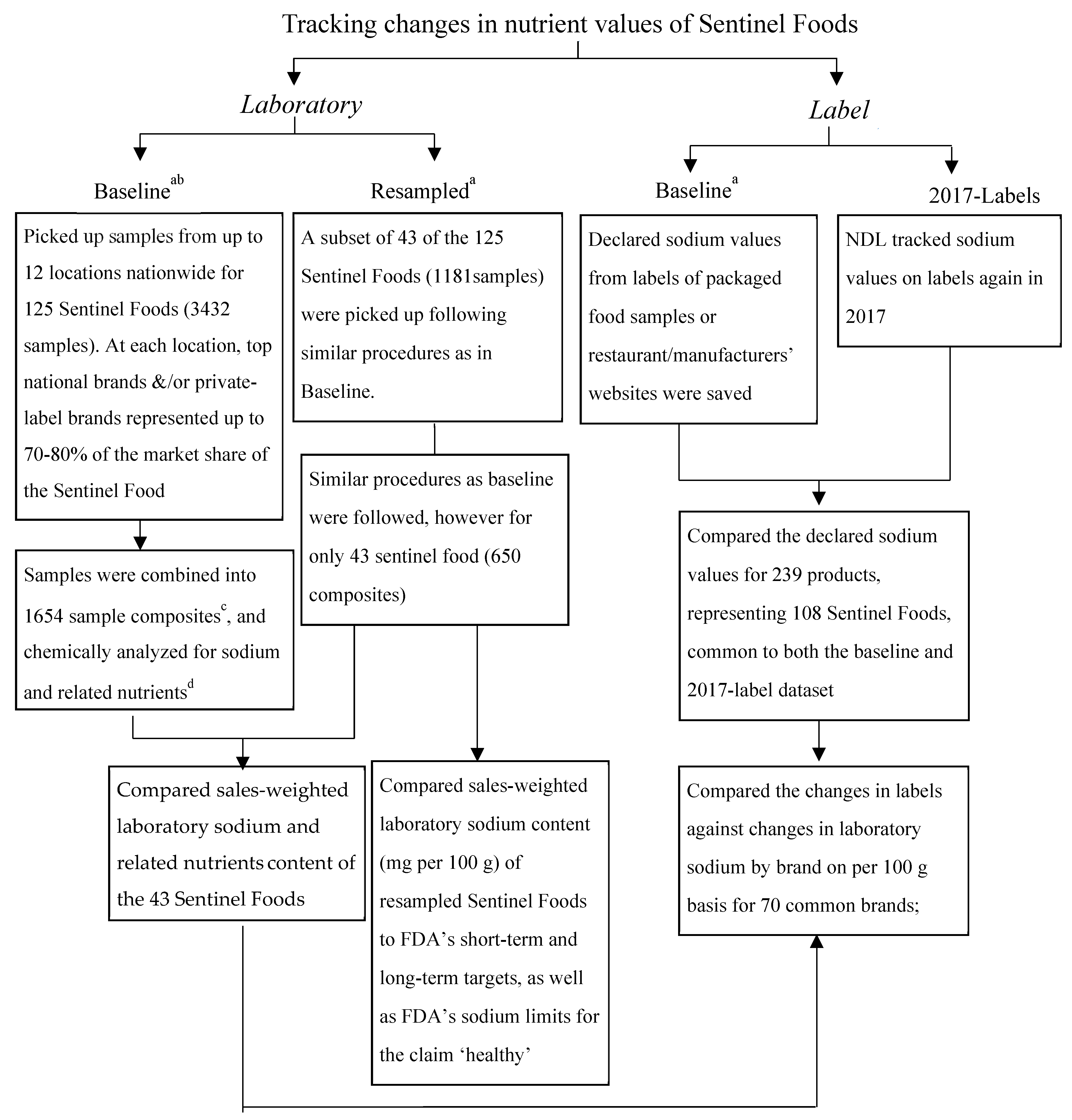
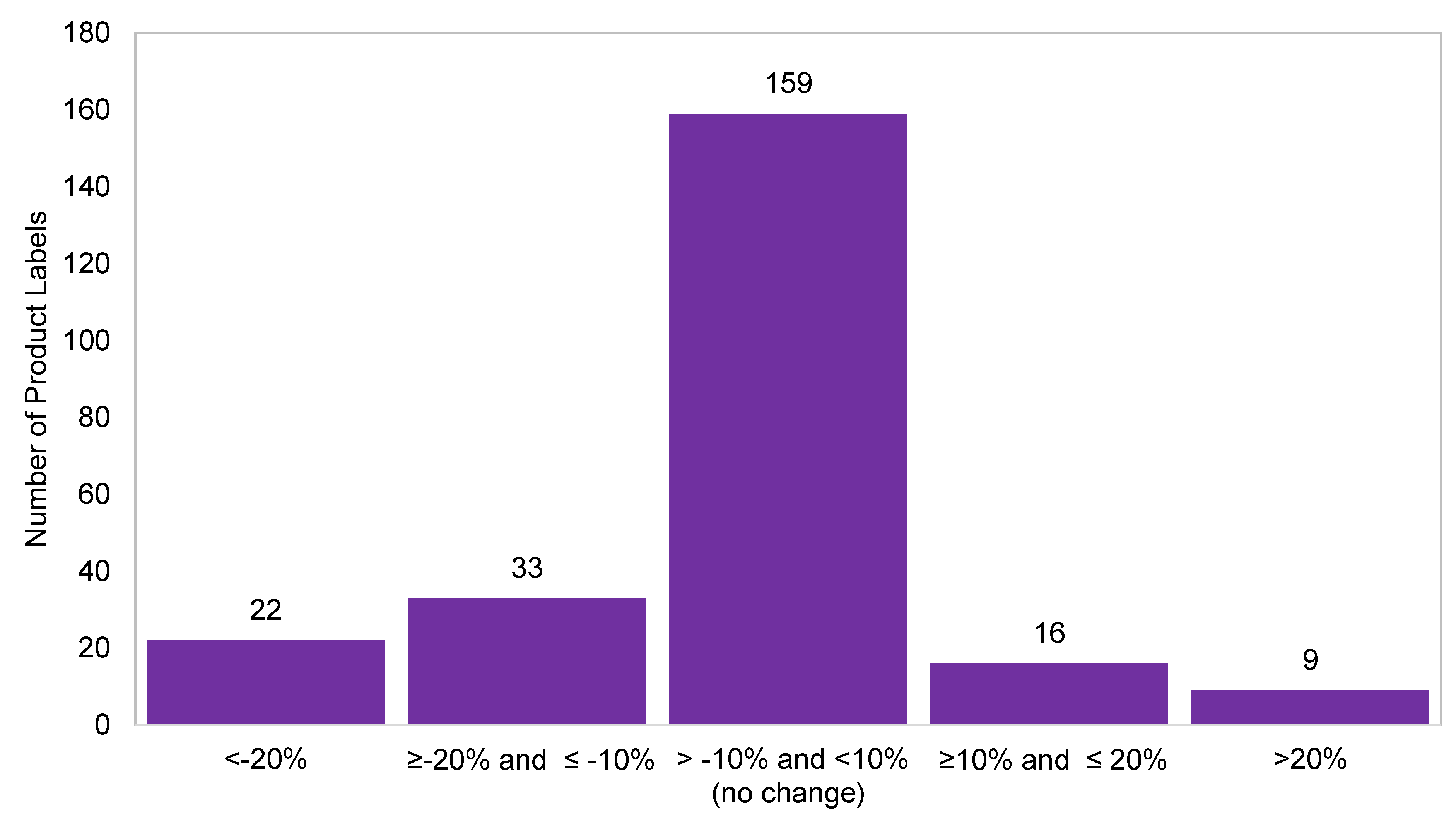
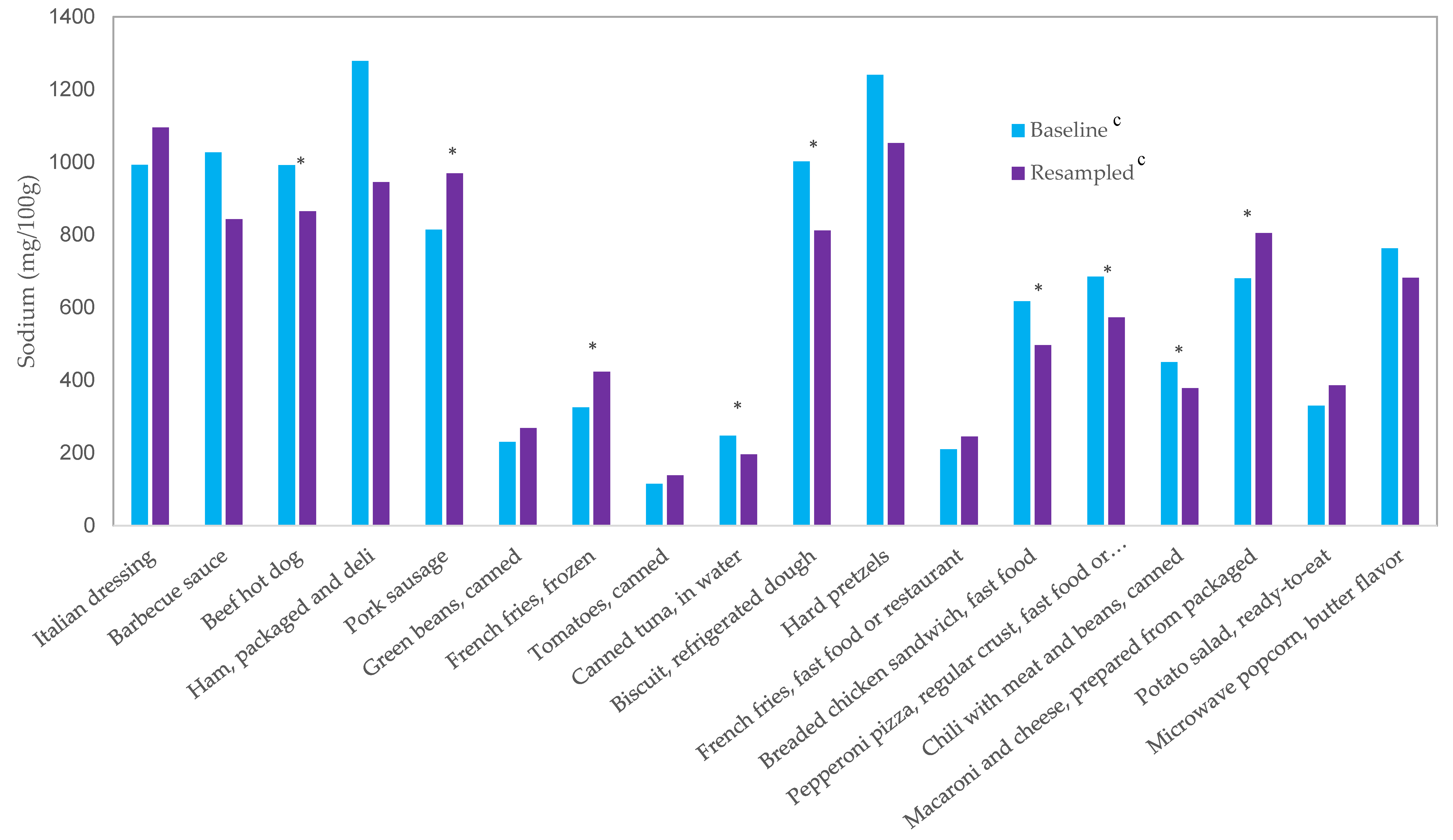
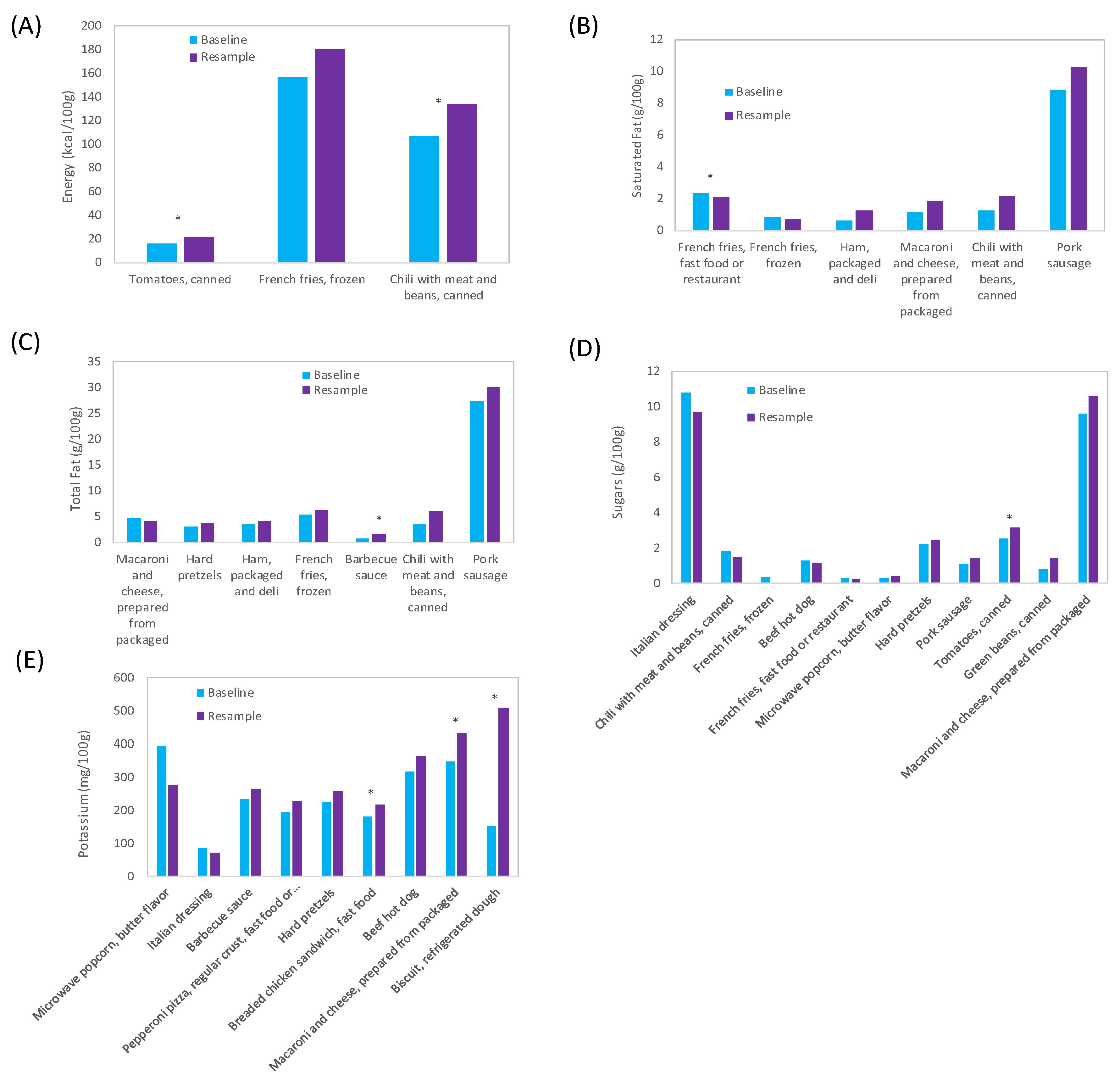
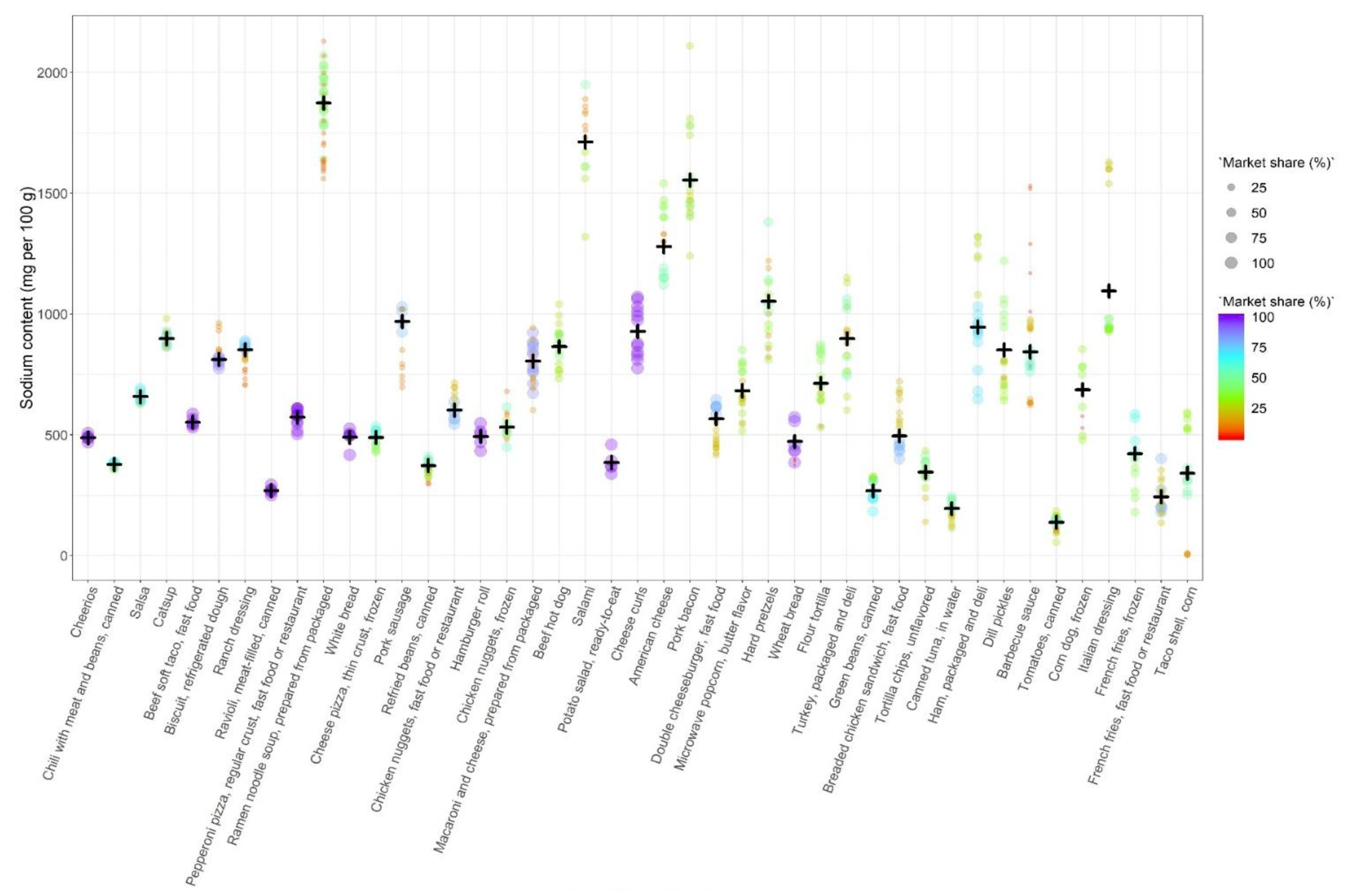
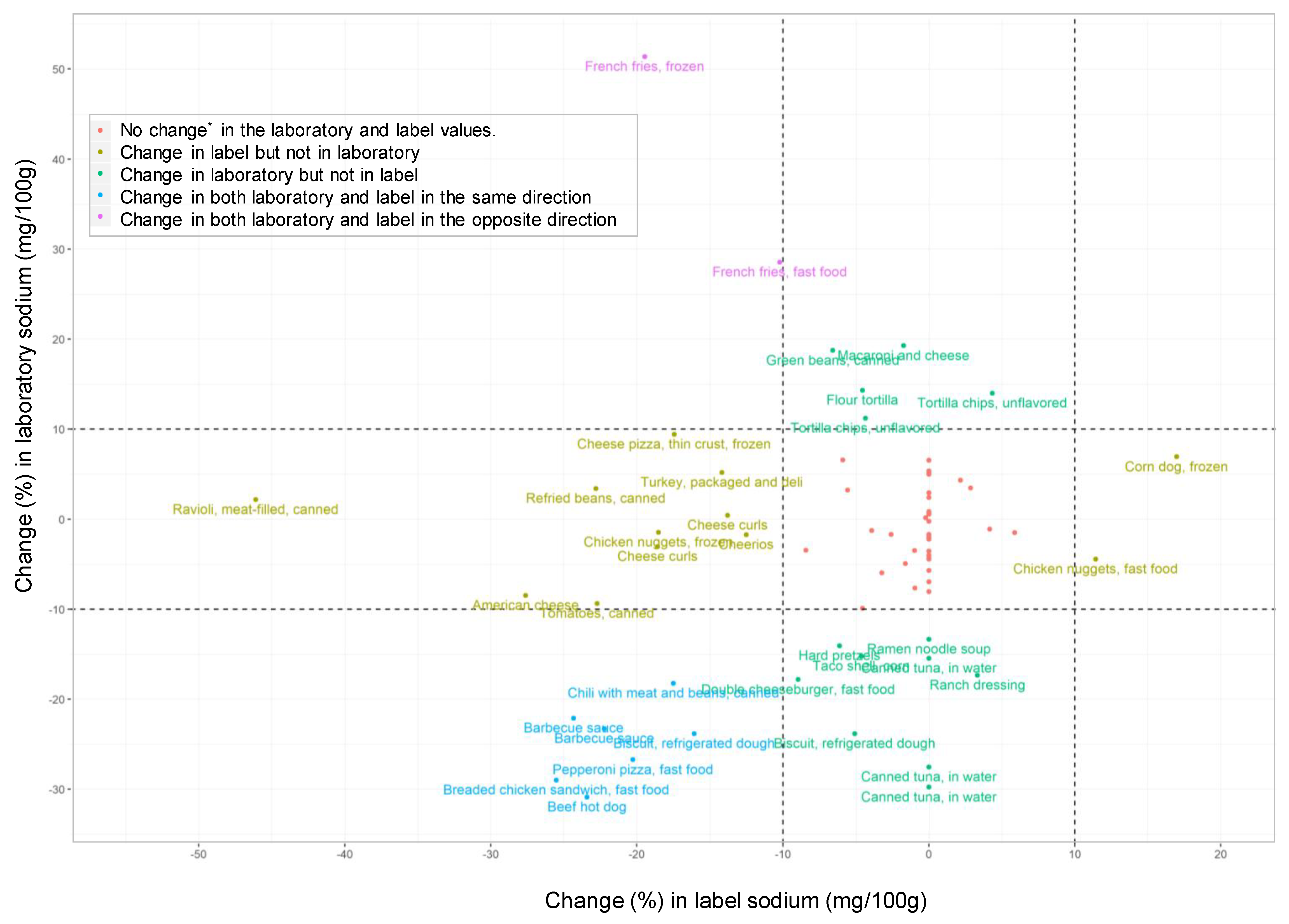
| Food Category | Sentinel Food Description |
|---|---|
| Breads, Rolls, Tortillas | |
| Flour tortilla | |
| Hamburger roll | |
| Taco shell, corn | |
| Wheat bread | |
| White bread | |
| Breakfast Cereals | |
| Cheerios | |
| Cheese | |
| American cheese | |
| Condiments and Sauces | |
| Barbecue sauce | |
| Catsup | |
| Dill pickles | |
| Salsa | |
| Cured Meats/Poultry | |
| Beef hot dog | |
| Ham, packaged and deli | |
| Pork bacon | |
| Pork sausage | |
| Salami | |
| Turkey, packaged and deli | |
| Grain Based Mixed Dishes | |
| Macaroni and cheese, prepared from packaged | |
| Ravioli, meat-filled, canned | |
| Meat and Poultry Mixed Dishes | |
| Chili with meat and beans, canned | |
| Mexican Mixed Dishes | |
| Beef soft taco, fast food | |
| Pizza | |
| Cheese pizza, thin crust, frozen | |
| Pepperoni pizza, regular crust, fast food or restaurant | |
| Plant-Based Protein Foods | |
| Refried beans, canned | |
| Potato Products | |
| French fries, fast food or restaurant | |
| French fries, frozen | |
| Potato salad, ready-to-eat | |
| Poultry Products | |
| Chicken nuggets, fast food or restaurant | |
| Chicken nuggets, frozen | |
| Quick Bread Products | |
| Biscuit, refrigerated dough | |
| Salad dressings and mayonnaise | |
| Italian dressing | |
| Ranch dressing | |
| Sandwiches | |
| Breaded chicken sandwich, fast food | |
| Corn dog, frozen | |
| Double cheeseburger, fast food | |
| Savory Snacks and Crackers | |
| Cheese curls | |
| Hard pretzels | |
| Microwave popcorn, butter flavor | |
| Tortilla chips, unflavored | |
| Seafood Products | |
| Canned tuna, in water | |
| Soups | |
| Ramen noodle soup, prepared from packaged | |
| Vegetable Products | |
| Green beans, canned | |
| Tomatoes, canned |
| Food Item | Baseline | 2017-Label | |||||
|---|---|---|---|---|---|---|---|
| Serving Weight (g) | Sodium Value (mg/Serving) | Sodium Value (mg/100 g) | Serving Weight (g) | Sodium Value (mg/Serving) | Sodium Value (mg/100 g) | Change from Baseline (%) c | |
| Asian Mixed Dishes | |||||||
| Vegetable egg roll (Brand A) d | 85 | 420 | 494 | 71 | 390 | 549 | 11 |
| Vegetable egg roll (Brand B) | 87 | 410 | 471 | 87 | 460 | 529 | 12 |
| Vegetable egg roll (Brand C) | 89 | 410 | 461 | 86 | 460 | 535 | 16 |
| Breads, Rolls, Tortillas | |||||||
| Flour tortilla (Brand A) | 120 | 300 | 250 | 43 | 160 | 372 | 49 |
| Flour tortilla (Brand B) | 49 | 440 | 898 | 45 | 320 | 711 | −21 |
| Hamburger roll e | 39 | 150 | 385 | 43 | 230 | 535 | 39 |
| Hamburger roll e | 39 | 150 | 385 | 43 | 230 | 535 | 39 |
| White bread | 28 | 130 | 464 | 26 | 140 | 538 | 16 |
| Breakfast Cereals | |||||||
| Cheerios | 28 | 160 | 571 | 28 | 140 | 500 | −13 |
| Frosted flakes | 30 | 140 | 467 | 29 | 150 | 517 | 11 |
| Cheese | |||||||
| American cheese (Brand A) | 19 | 250 | 1316 | 21 | 220 | 1048 | −20 |
| American cheese (Brand B) | 21 | 270 | 1286 | 19 | 340 | 1789 | 39 |
| Fried mozzarella sticks, fast food or restaurant | 2640 | 2140 | −19 * | ||||
| Mozzarella cheese, part-skim | 28 | 200 | 714 | 28 | 180 | 643 | −10 |
| Parmesan cheese, grated | 5 | 85 | 1700 | 5 | 75 | 1500 | −12 |
| Condiments and Sauces | |||||||
| Barbecue sauce (Brand A) | 36 | 370 | 1028 | 36 | 280 | 778 | −24 |
| Barbecue sauce (Brand B) | 36 | 450 | 1250 | 36 | 350 | 972 | −22 |
| Nacho cheese dip | 34 | 280 | 824 | 30 | 340 | 1116 | 36 |
| Cured Meats/Poultry | |||||||
| Beef hot dog (Brand A) | 57 | 550 | 965 | 57 | 480 | 842 | −13 |
| Beef hot dog (Brand B) | 45 | 470 | 1044 | 42 | 360 | 857 | −18 |
| Bologna | 28 | 280 | 1000 | 32 | 390 | 1219 | 22 |
| Ham, packaged and deli | 28 | 310 | 1107 | 56 | 500 | 893 | −19 |
| Meat and poultry hot dog | 45 | 350 | 778 | 45 | 420 | 933 | 20 |
| Pork sausage | 68 | 710 | 1044 | 68 | 510 | 750 | −28 |
| Turkey, packaged and deli | 51 | 460 | 902 | 28 | 210 | 750 | −17 |
| Grain Based Mixed Dishes | |||||||
| Lasagna with meat, fast food or restaurant | 421 | 2830 | 672 | 2070 | −27 * | ||
| Lasagna with meat, frozen (Brand A) | 227 | 860 | 379 | 227 | 980 | 432 | 14 |
| Lasagna with meat, frozen (Brand B) e | 215 | 670 | 312 | 297 | 820 | 276 | −11 |
| Lasagna with meat, frozen (Brand B) e | 215 | 860 | 400 | 297 | 820 | 276 | −31 |
| Macaroni and cheese, fast food or restaurant (Brand A) | 180 | 570 | 317 | 650 | 14 * | ||
| Macaroni and cheese, fast food or restaurant (Brand B) | 236 | 1530 | 648 | 1220 | −20 * | ||
| Ravioli, meat-filled, canned (Brand A) e | 252 | 700 | 278 | 425 | 750 | 176 | −36 |
| Ravioli, meat-filled, canned (Brand A) e | 252 | 950 | 377 | 425 | 750 | 176 | −53 |
| Ravioli, meat-filled, canned (Brand B) | 254 | 1050 | 413 | 254 | 750 | 295 | −29 |
| Spaghetti with meatballs, canned | 250 | 1050 | 420 | 255 | 750 | 294 | −30 |
| Meat and Poultry Mixed Dishes | |||||||
| Chicken pot pie, frozen | 234 | 800 | 342 | 200 | 750 | 375 | 10 |
| Chicken pot pie, frozen (Brand A) | 198 | 790 | 399 | 198 | 930 | 470 | 18 |
| Chicken pot pie, frozen (Brand A) | 283 | 1000 | 353 | 198 | 930 | 470 | 33 |
| Chili with meat and beans, canned | 247 | 1200 | 486 | 247 | 990 | 401 | −18 |
| Chili with meat and beans, fast food or restaurant | 1010 | 1130 | 12 * | ||||
| Mexican Mixed Dishes | |||||||
| Bean burrito, fast food | 198 | 960 | 485 | 1060 | 10 * | ||
| Pizza | |||||||
| Cheese pizza, thick crust, fast food or restaurant | 125 | 750 | 600 | 125 | 640 | 512 | −15 |
| Cheese pizza, thin crust, fast food or restaurant (Brand A) | 76 | 350 | 461 | 88 | 460 | 523 | 14 |
| Cheese pizza, thin crust, fast food or restaurant (Brand B) | 89 | 800 | 899 | 89 | 610 | 685 | −24 |
| Cheese pizza, thin crust, frozen | 146 | 890 | 610 | 149 | 750 | 503 | −17 |
| Pepperoni pizza, regular crust, fast food or restaurant | 108 | 740 | 685 | 590 | −20 * | ||
| Pepperoni pizza, thick crust, fast food or restaurant | 123 | 910 | 740 | 700 | −23 * | ||
| Plant-Based Protein Foods | |||||||
| Peanuts, dry roasted, salted | 28 | 170 | 607 | 28 | 150 | 536 | −12 |
| Refried beans, canned | 120 | 570 | 475 | 120 | 440 | 367 | −23 |
| Potato Products | |||||||
| French fries, fast food or restaurant | 117 | 270 | 231 | 111 | 230 | 207 | −10 |
| French fries, frozen (Brand A) | 84 | 360 | 429 | 84 | 290 | 345 | −19 |
| French fries, frozen (Brand B) | 84 | 410 | 488 | 84 | 270 | 321 | −34 |
| Hash browns, fast food | 168 | 810 | 482 | 169 | 1140 | 675 | 40 |
| Tater tots, frozen | 84 | 400 | 476 | 84 | 330 | 393 | −18 |
| Poultry Products | |||||||
| Chicken nuggets, fast food or restaurant | 60 | 350 | 583 | 60 | 390 | 650 | 11 |
| Chicken nuggets, frozen | 85 | 540 | 635 | 85 | 360 | 424 | −33 |
| Chicken tenders, fast food or restaurant | 201 | 1320 | 657 | 940 | −29 * | ||
| Chicken tenders, frozen | 85 | 460 | 541 | 84 | 600 | 714 | 32 |
| Quick Bread Products | |||||||
| Biscuit, refrigerated dough | 58 | 560 | 966 | 58 | 470 | 810 | −16 |
| Blueberry muffin | 50 | 150 | 300 | 47 | 190 | 404 | 35 |
| Sandwiches | |||||||
| Breaded chicken sandwich, fast food | 143 | 800 | 559 | 144 | 600 | 417 | −26 |
| Corn dog, frozen (Brand A) | 75 | 540 | 720 | 75 | 470 | 627 | −13 |
| Corn dog, frozen (Brand B) | 76 | 460 | 605 | 113 | 800 | 708 | 17 |
| Hamburger, fast food | 100 | 460 | 460 | 93 | 380 | 409 | −11 |
| Savory Snacks and Crackers | |||||||
| Cheese curls (Brand A) | 28 | 290 | 1036 | 28 | 250 | 893 | −14 |
| Cheese curls (Brand B) | 28 | 350 | 1250 | 28 | 300 | 1071 | −14 |
| Cracker, saltine | 16 | 150 | 938 | 16 | 135 | 844 | −10 |
| Microwave popcorn, butter flavor (Brand A) | 33 | 390 | 1182 | 34 | 300 | 882 | −25 |
| Microwave popcorn, butter flavor (Brand B) | 30 | 350 | 1167 | 32 | 300 | 938 | −20 |
| Potato chips, flavored | 28 | 230 | 821 | 28 | 200 | 714 | −13 |
| Tortilla chips, flavored | 28 | 250 | 893 | 28 | 210 | 750 | −16 |
| Seafood Products | |||||||
| Canned tuna, in water | 56 | 215 | 384 | 56 | 180 | 321 | −16 |
| Fish sticks, frozen | 86 | 480 | 558 | 95 | 420 | 442 | −21 |
| Fried shrimp, fast food or restaurant | 1270 | 590 | −54 * | ||||
| Soups | |||||||
| Chicken broth, canned, ready to serve | 245 | 970 | 396 | 245 | 860 | 351 | −11 |
| Sweet Bakery Products | |||||||
| Chocolate sandwich cookie | 34 | 160 | 471 | 34 | 130 | 382 | −19 |
| Vegetable Products | |||||||
| Green beans, canned (Brand A) | 116 | 400 | 345 | 121 | 320 | 264 | −23 |
| Green beans, canned (Brand B) | 116 | 330 | 284 | 120 | 290 | 242 | −15 |
| Tomatoes, canned (Brand A) | 121 | 220 | 182 | 121 | 170 | 140 | −23 |
| Tomatoes, canned (Brand B) | 121 | 220 | 182 | 121 | 180 | 149 | −18 |
| Food Item | Baseline Sales-Weighted Sodium Mean (SD) f | Resampled Sales-Weighted Sodium (mg per 100 g) | Change from Baseline (%) | FDA Targets (mg per 100 g) | Difference (%) between Resampled Laboratory Sodium and FDA Target h | |||||
|---|---|---|---|---|---|---|---|---|---|---|
| n | Mean (SD) | Range | CV (%) g | Short-Term | Long-Term | Short-Term | Long-Term | |||
| Breads, Rolls, Tortillas | ||||||||||
| Wheat bread | 508(48) | 10 | 472(68) | 375–573 | 15 | −7 | 420 | 300 | 13 | 58 |
| Hamburger roll | 499(34) | 5 | 493(39) | 433–548 | 8 | −1 | 440 | 300 | 12 | 65 |
| White bread | 490(40) | 6 | 490(34) | 417–526 | 7 | 0 | 440 | 300 | 11 | 63 |
| Flour tortilla | 708(73) | 16 | 712(105) | 531–873 | 15 | 1 | 580 | 410 | 23 | 74 |
| Taco shell, corn | 323(168) | 17 | 341(181) | 3−593 | 53 | 5 | 490 | 320 | −30 | 7 |
| Breakfast Cereals | ||||||||||
| Cheerios | 496(0) | 6 | 488(11) | 468–507 | 2 | −2 | 470 | 310 | 4 | 57 |
| Cheese | ||||||||||
| American cheese i | 1308(66) | 16 | 1279(142) | 1120–1540 | 11 | −2 | 1210 | 1000 | 6 | 28 |
| Condiments and Sauces | ||||||||||
| Barbecue sauce | 1026(292) | 28 | 843(166) | 623–1530 | 20 | −18 | 900 | 760 | −6 | 11 |
| Salsa | 710(37) | 12 | 657(20) | 626–692 | 3 | −7 | 500 | 350 | 32 | 88 |
| Catsup | 906(37) | 18 | 897(28) | 860–981 | 3 | −1 | 900 | 760 | 0 | 18 |
| Dill pickles | 809(218) | 18 | 850(168) | 643–1220 | 20 | 5 | 500 | 410 | 70 | 108 |
| Cured Meats/Poultry | ||||||||||
| Ham, packaged and deli | 1278(240) | 18 | 945(174) | 647–1320 | 18 | −26 | 1020 | 810 | −7 | 17 |
| Beef hot dog | 992(109) | 17 | 864(82) | 732–1040 | 9 | −13 * | 900 | 730 | −4 | 18 |
| Pork bacon i | 1684(139) | 18 | 1554(186) | 1240–2110 | 12 | −8 | 1700 | 1200 | −8 | 30 |
| Salami i | 1756(206) | 13 | 1712(182) | 1320–1950 | 11 | −3 | 1630 | 1300 | 5 | 32 |
| Turkey, packaged and deli i | 922(142) | 18 | 897(154) | 603–1150 | 17 | −3 | 900 | 780 | 0 | 15 |
| Pork sausage i | 813(103) | 13 | 969(73) | 697–1030 | 8 | 19 * | 850 | 750 | 14 | 29 |
| Grain Based Mixed Dishes | ||||||||||
| Ravioli, meat-filled, canned i,j | 282(48) | 6 | 269(13) | 249–293 | 5 | −5 | 330 | 220 | −18 | 23 |
| Macaroni and cheese, prepared from packaged i,j,k | 680(54) | 24 | 804(74) | 603–943 | 9 | 18 * | 750 | 490 | 7 | 64 |
| Meat and Poultry Mixed Dishes | ||||||||||
| Chili with meat and beans, canned i,j | 449(20) | 12 | 377(9) | 354–388 | 3 | −16 * | 330 | 220 | 15 | 72 |
| Mexican Mixed Dishes | ||||||||||
| Beef soft taco, fast food i | 559(25) | 6 | 552(18) | 530–587 | 3 | −1 | 390 | 220 | 42 | 151 |
| Pizza | ||||||||||
| Pepperoni pizza, regular crust, fast food or restaurant i,j | 684(75) | 12 | 572(34) | 503–610 | 6 | −16 * | 460 | 310 | 25 | 85 |
| Cheese pizza, thin crust, frozen i | 471(14) | 12 | 489(35) | 428–535 | 7 | 4 | 420 | 260 | 16 | 88 |
| Plant-Based Protein Foods | ||||||||||
| Refried beans, canned i | 370(43) | 18 | 373(28) | 298–411 | 8 | 1 | 290 | 250 | 29 | 49 |
| Potato Products | ||||||||||
| French fries, fast food or restaurant | 209(55) | 18 | 243(72) | 137–402 | 30 | 16 | 310 | 190 | −21 | 28 |
| Potato salad, ready-to-eat i | 329(72) | 5 | 385(41) | 338–460 | 11 | 17 | 300 | 140 | 29 | 176 |
| French fries, frozen | 324(48) | 11 | 422(120) | 179–586 | 28 | 30 * | 310 | 190 | 36 | 123 |
| Poultry Products | ||||||||||
| Chicken nuggets, frozen i | 560(50) | 15 | 529(47) | 449–679 | 9 | −5 | 570 | 420 | −7 | 26 |
| Chicken nuggets, fast food or restaurant i | 594(80) | 12 | 602(47) | 544–714 | 8 | 1 | 570 | 420 | 6 | 44 |
| Quick Bread Products | ||||||||||
| Biscuit, refrigerated dough | 1002(101) | 12 | 811(37) | 774–962 | 5 | −19 * | 820 | 500 | −1 | 62 |
| Salad dressings and mayonnaise | ||||||||||
| Ranch dressing | 901(60) | 18 | 851(39) | 705–890 | 5 | −6 | 880 | 590 | −3 | 44 |
| Italian dressing i | 992(42) | 18 | 1095(275) | 926–1630 | 25 | 10 | 880 | 590 | 25 | 86 |
| Sandwiches | ||||||||||
| Breaded chicken sandwich, fast food i | 616(32) | 18 | 496(88) | 400–721 | 18 | −20 | 470 | 310 | 6 | 60 |
| Corn dog, frozeni | 668(87) | 10 | 686(155) | 479–853 | 23 | 3 | 610 | 400 | 13 | 72 |
| Double cheeseburger, fast food i | 617(86) | 18 | 566(74) | 417–645 | 13 | −8 | 480 | 300 | 18 | 89 |
| Savory Snacks and Crackers | ||||||||||
| Hard pretzels i | 1240(272) | 17 | 1052(152) | 811–1380 | 14 | −15 | 1020 | 750 | 3 | 40 |
| Microwave popcorn, butter flavor | 762(163) | 18 | 681(96) | 516–851 | 14 | −11 | 680 | 400 | 0 | 70 |
| Cheese curls | 942(120) | 12 | 927(100) | 775–1070 | 11 | −2 | 870 | 550 | 7 | 69 |
| Tortilla chips, unflavored | 327(46) | 16 | 346(62) | 140–434 | 18 | 6 | 390 | 300 | −11 | 15 |
| Seafood Products | ||||||||||
| Canned tuna, in water | 246(58) | 18 | 194(35) | 112–242 | 18 | −21 * | 360 | 260 | −46 | −25 |
| Soups | ||||||||||
| Ramen noodle soup, prepared from packaged i,j,k | 1855(132) | 44 | 1874(124) | 1560–2130 | 7 | 1 | 1640 | 1290 | 14 | 45 |
| Vegetable Products | ||||||||||
| Green beans, canned | 229(24) | 12 | 268(46) | 183–328 | 17 | 17 | 290 | 250 | −8 | 7 |
| Tomatoes, canned | 115(37) | 18 | 138(29) | 56–184 | 21 | 20 | 290 | 250 | −52 | −45 |
© 2019 by the authors. Licensee MDPI, Basel, Switzerland. This article is an open access article distributed under the terms and conditions of the Creative Commons Attribution (CC BY) license (http://creativecommons.org/licenses/by/4.0/).
Share and Cite
Ahuja, J.K.C.; Li, Y.; Haytowitz, D.B.; Bahadur, R.; Pehrsson, P.R.; Cogswell, M.E. Assessing Changes in Sodium Content of Selected Popular Commercially Processed and Restaurant Foods: Results from the USDA: CDC Sentinel Foods Surveillance Program. Nutrients 2019, 11, 1754. https://doi.org/10.3390/nu11081754
Ahuja JKC, Li Y, Haytowitz DB, Bahadur R, Pehrsson PR, Cogswell ME. Assessing Changes in Sodium Content of Selected Popular Commercially Processed and Restaurant Foods: Results from the USDA: CDC Sentinel Foods Surveillance Program. Nutrients. 2019; 11(8):1754. https://doi.org/10.3390/nu11081754
Chicago/Turabian StyleAhuja, Jaspreet K. C., Ying Li, David B. Haytowitz, Rahul Bahadur, Pamela R. Pehrsson, and Mary E. Cogswell. 2019. "Assessing Changes in Sodium Content of Selected Popular Commercially Processed and Restaurant Foods: Results from the USDA: CDC Sentinel Foods Surveillance Program" Nutrients 11, no. 8: 1754. https://doi.org/10.3390/nu11081754
APA StyleAhuja, J. K. C., Li, Y., Haytowitz, D. B., Bahadur, R., Pehrsson, P. R., & Cogswell, M. E. (2019). Assessing Changes in Sodium Content of Selected Popular Commercially Processed and Restaurant Foods: Results from the USDA: CDC Sentinel Foods Surveillance Program. Nutrients, 11(8), 1754. https://doi.org/10.3390/nu11081754





